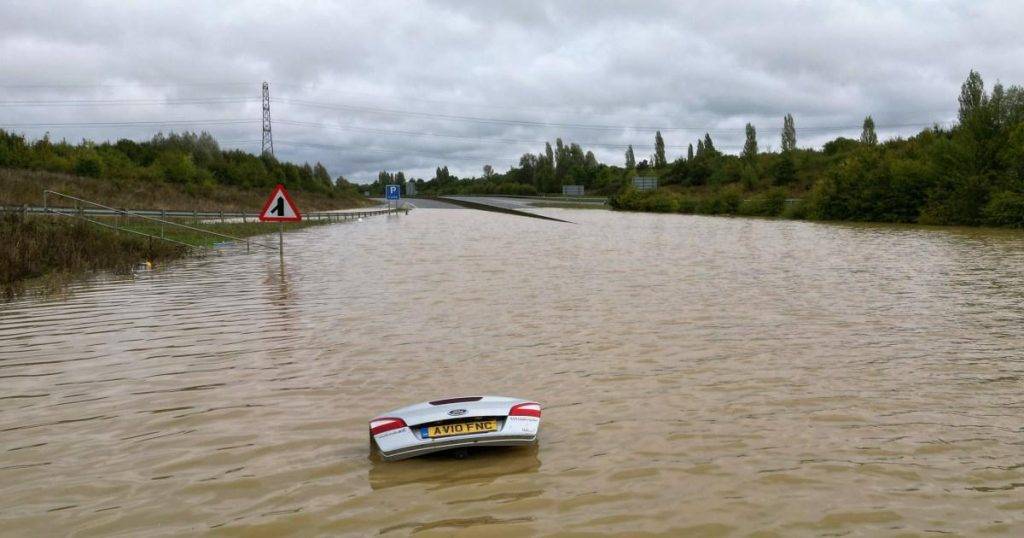Why is the UK still so poorly prepared for extreme weather? It is 2025 and we have an abundance of weather warnings but yet flooding, disruption and transport chaos aplenty. So how should the nation prepares for another period of unsettled conditions.
Not only were New Year celebrations cancelled and train journeys disrupted due to wild winds, but alerts about potentially life-threatening cold weather conditions also hit the headlines ahead of this this weekend.
Why is the UK still so poorly prepared for extreme weather
As we see year on year, large areas of the UK can struggle to cope when extreme weather arrives. Just this week, a major incident was declared after torrential rain left parts of Greater Manchester, Lancashire and Cheshire flooded.
Earlier this winter, a flooded tunnel at London’s Farringdon station brought Thameslink services to a standstill, while ‘significant leaf fall’ caused by high volumes of water forced a closure to part of the Underground’s Piccadilly line.
Elsewhere, dramatic images have captured the moments roads turned into rivers and trees toppled onto key transport routes in more rural areas.
Rain, sleet and winds moving in from the West
At least five people died in England and Wales when Storm Bert struck in November, one of whom was 75-year-old Brian Perry, who went missing in North Wales as he walked his dog. When Storm Darragh arrived the following month, England rugby international Tom Voyce lost his life when his car came off the Abberwick Ford, near Alnwick, amid strong currents.
Unless further action is taken, experts warn more lives will be put at risk, especially when it comes to flooding.
‘We need to shift from the mentality about “if” there will be another flood to “when” it will be, and how ready we are,’ explains Dr Steven Forrest, lecturer in flood resilience and sustainable transformations at the University of Hull.
He said: ‘Often, we are reactive. Authorities often wait for an incident to happen then put money into repairing it. Then they kind of forget about it.
‘We need to strengthen the support and money available to communities to work out what we can learn from each flooding incident and what we can do to be more prepared next time.’
Pointing to nail-biting situations where drivers risk their lives to cross flooded roads, Dr Forrest adds: ‘Some people underestimate the volume of water and the potential debris they are driving over.
How to prepare for a flood – A guide to surviving if your home is flooded
Why is the UK still so poorly prepared for extreme weather?
‘With tunnels and underpasses, you may not realise how deep it is until you’re floating and it’s too late.
‘We recently saw a tractor cross a flooded area, which created “bow waves”, almost like a boat, and this continuous movement of water can wear away at materials and damage homes.’
Hull, where Dr Forrest is based, is no stranger to horrific floods. In 2013, around 1,100 properties and over 7,000 hectares of land flooded after gusts of up to 90mph whipped up the North Sea and a huge tidal storm surge moved down the coast.
And in 2007, the city’s drainage systems were overwhelmed on the wettest day in one of the wettest months in living memory.
The cost of repair to the area was put at more than £40m. Across the country that same year, severe floods caused 13 deaths and damaged 55,000 homes and businesses, with the disaster deemed the nation’s largest peacetime emergency since World War II.
The capital is also at risk
Stranded cars and residents battle the flood waters in the village of North Cave, near Hull in northern England on 25 June, 2007.
After the tidal surge in 2013, residents had to be rescued by the RNLI in Rhyl, north Wales
‘London is not prepared for another major surface water flooding incident and lives and livelihoods are at risk,’ the London Climate Resilience Review warned in 2024.
The Thames Barrier, which protects the capital from being engulfed by water, gets closed whenever there are storm surge conditions to save 1.4 million Londoners from being engulfed by water. The Barrier is expected to last until 2070, ahead of which a decision will need to be made to build a new version or upgrade the existing one.
Flooding reveals the underlying vulnerabilities
‘Flooding in itself isn’t a “natural” disaster,’ Dr Forrest adds. ‘The hazard of large volumes of water is natural, but the consequences we feel are from human choices and decisions.
Flooding reveals the underlying vulnerabilities and weaknesses in our systems, whether that’s poor design and maintenance of infrastructure and buildings, spatial planning that doesn’t account for water and ignores flood risk, and people in precarious situations with limited (or no) financial security.
‘These problems exist before the flood arrives, but [the water] shines a light on them and can even exacerbate these issues – leading to these flood disasters that we’re seeing.’
As ocean temperatures rise and the glaciers melt, global sea levels in turn rise. This has a direct knock-on effect on our coastal areas. In short, flooding is only going to become more common as climate change worsens.
In the UK, we are more likely to see our homes flooded than burgled. Yet while people invest in security alarms or hide valuables away, it can be a different story when it comes to preparation for wild weather.
According to the Red Cross, just 1 in 6 adults are signed up to receive flood warnings which means people can be caught unaware in dangerous situations.
Skipton in North Yorkshire
‘I don’t think people often realise how devastating a flood can be,’ says Tracey Garrett, CEO of the National Flood Forum. The charity runs a helpline and recovery services for people whose lives have been upturned by wild weather.
‘It’s not just water in your home; it can be filthy and often contain sewage, for many people, it can erode any sense of security they feel at home.
‘Flooding can wipe out years of memories such as photo albums, grandma’s rocking chair or even those notches on the door post in the kitchen where you marked your kids’ heights. These are the things that make a house a home.
‘Another thing that people don’t always realise is that recovering from a flood can take years. It takes a long time to dry out a home and restore it. It can take even longer for people to recover from the shock and trauma of flooding.’
Tracey is originally from Skipton in North Yorkshire, a region which has been repeatedly battered by storms. She still remembers floods from her childhood, which saw parts of the town entirely immersed in water and only passable by boat. Thanks to a flood defence scheme in Skipton, that no longer happens. But, elsewhere, similar precautions haven’t been put in place.
Low-income households are sadly eight times more likely
‘We hear lots of terrible stories of being flooded and many of those really stick with you,’ Tracey adds. ‘There are people who are unable to sleep every time it rains, who are traumatised and watch the level of water in their street constantly.’
Nearly two thirds of low-income renters are without home contents insurance, leaving them vulnerable to devastating financial consequences.
Recent ITV show ‘After The Flood’, which starred Peaky Blinders’ Sophie Rundle, has helped raise awareness of the severity of flooding. It depicted the aftermath of flash flooding in a small English town in terrifying style; with a newborn baby nearly swept away by water in the opening scene.
She adds: ‘When it floods communities often come together as we saw in Tenbury Wells and Pontypridd recently. However, it’s important that we start to look at the ways we tackle the bigger issues around increasingly rapid climate change and how we help communities in the face of that change.



